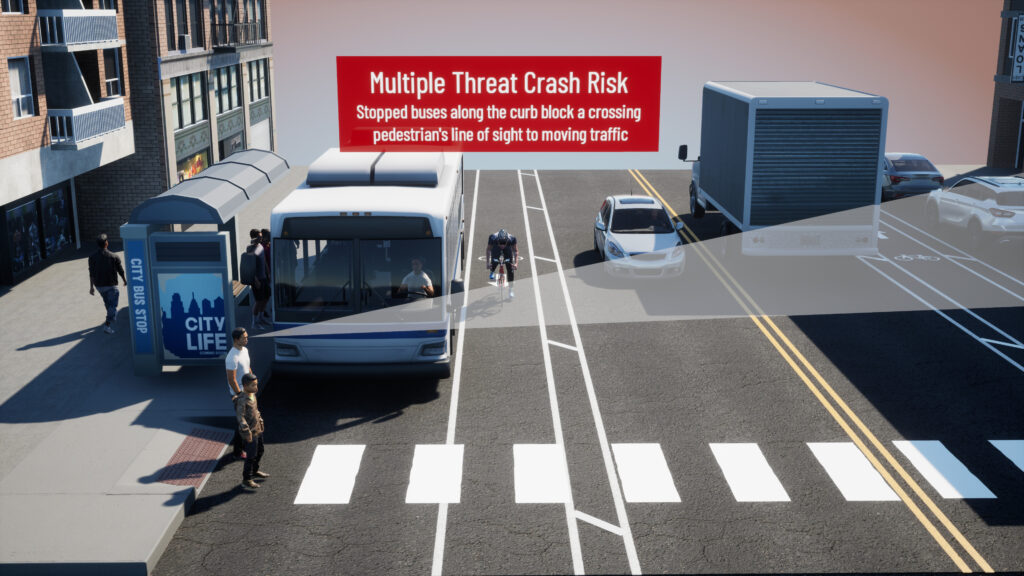The urban landscape is rapidly evolving to meet ever-changing transportation safety & mobility demands. With the recent surge in Uber and Lyft ride-share trips, sharable scooters, and e-bikes – not to mention autonomous vehicles on the horizon – the ways in which people travel on city streets look much different than when those roads were last designed and built.
During that same period, cities have embraced Complete Streets, Vision Zero Death, and VMT reduction policies to counteract rising pedestrian fatalities, mobility inequities, and climate change. Urban planners and engineers are now constantly working to reconfigure their busy streets to make things simpler and safer for the most vulnerable users – people biking, walking, and rolling – as they are often overrepresented in the number of crashes resulting in serious injury or death.
As cities continue to evolve their transportation systems to prioritize safety and sustainability, reconfiguring busy streets to reduce the risk of “multiple-threat” pedestrian crashes is an important consideration. This may involve rethinking the use of curbside bus pull-outs, which can create visibility challenges and increase the risk of collisions with pedestrians.
This type of pedestrian crash risk is one that is inherently dangerous for the street’s most vulnerable users, and countermeasures should be evaluated while considering roadway reconfigurations.
A multiple-threat crash is normally thought of in this scenario:
A driver in an interior lane of a multi-lane road strikes a pedestrian crossing the road because a vehicle in the exterior lane stopped for that pedestrian to let them cross. The stopped vehicle in the exterior lane often blocks the line-of-sight between the driver in the interior lane and the crossing pedestrian.

This type of crash risk is particularly dangerous from the combination of several factors. First, a pedestrian is obviously extremely vulnerable to a moving vehicle. Second, because line-of-sight is blocked between both the driver and the pedestrian, the crash is generally sudden and unexpected. Third, because of the unexpected nature of the crash, the driver’s speed may contribute to a higher risk of serious injury or fatality.
The scenario described above is only one form of a multiple-threat crash. The same crash risk is also present on two-lane city streets when parked cars or stopped buses along the curb are impairing visibility from a single lane of moving traffic to crossing pedestrians.

Curbside bus pull-out areas are very common on city streets because they prioritize keeping traffic behind the bus moving without delay while the bus is boarding.
In a new era of Complete Street design, safety improvements, VMT reduction, and mode-shift encouragement (getting people out of cars and into transit or other types of active transportation) – bus pull-outs should no longer be considered the default bus stop without comparing through-traffic optimization with the benefits of other alternatives.
Removing a bus pull-out at a bus stop can come at a cost – long dwell times (the time the bus is stopped for people getting on and off the bus) can lead to queues of vehicles behind the bus.
Some dwell times are worth waiting for, because the benefits might far outweigh the delay.

- Space dedicated for a bus pull-out could be repurposed for other design features that improve the street as a space for people – a larger bus stop waiting area or bus boarding island, a new bus shelter, street furniture, green infrastructure, or public art.
- Bus route efficiency can improve – when a bus stops in-lane instead of pulling off to the side, it does not need to wait to find a gap in traffic to merge back in.
- If there is a bike lane on the road, dedicated bike space can be repositioned to a protected location that they don’t have to share with or cross over the path of a bus pulling out of lane.
- When buses stop in-lane instead of pulling over to the curb, the multiple-threat crash risk is either reduced or completely eliminated. A bus stopped in the travel lane removes one potentially-deadly conflict for the crossing pedestrian, who can shift their focus to traffic oncoming in the other direction as they cross the street.
While removing bus pull-outs may lead to longer dwell times for buses, the benefits of improving street design, enhancing bus route efficiency, and reducing the risk of pedestrian crashes may outweigh the costs. As cities work to create safer and more equitable transportation networks, evaluating multiple-threat crash risks and implementing targeted countermeasures will be critical to ensuring the safety of all road users.
The visuals used in this article have been made with Beyond Typicals, a simple yet powerful drag-and-drop 3D typical section creator that empowers designers & planners to build road visualizations in minutes and edit in real time.
Click here to sign up for a free 30-day trial of Beyond Typicals (no credit card needed).

Brian Sroufe, P.E.
Brian is a licensed professional engineer with 15 years of urban transportation design and project management experience. As Beyondware's Business Development Manager, he now demonstrates the incredible value that easily-assembled 3D roadway visualizations built with Beyond Typicals can bring to communicating transportation safety and mobility improvements.

